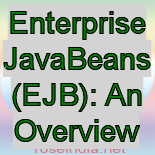Enterprise JavaBeans (EJB): An Overview
Enterprise JavaBeans (EJB) is a Java Platform based server-side component architecture, which is used for the modular construction of enterprise applications based on Java.
Initially, EJB was developed by software giant IBM, which was then implemented by Sun Microsystems. Later Java Community released the advance versions of EJB namely EJB 2.0, EJB 2.1, EJB 3.0, EJB 3.1. The latest version of Enterprise JavaBeans is EJB 3.2.
Before going into the depth of learning EJB, there are certain concepts every aspirant should know about EJB.
EJB Server
EJB server is the EJB application server, which may be a web server, mail server, print server, database or any other server. An EJB application server accepts the connections in order to accept the requests and finally respond to the request. EJB Servers can be run remotely or can exist on the same computer in which the client application is running.
EJB Containers
EJB Containers are specific frameworks for EJB responsible to manage control and provide services. In common, there are five types of EJB Containers in which three types are server-side containers and the remaining two are client-side containers.
The Server-side containers comprise of the server itself and provide a proper environment to EJB. The other type of EJB server-side containers is responsible to manage the EJB components. The web container manages the servlets and JavaServer Pages.
The Client-side Containers consists a container for the familiar Java applications which initiates with java commands and an applet container or browser enabled with Java Plug-in.
Enterprise Beans
Enterprise bean is a server-side component installed in the EJB containers that encapsulates the business logic of an application. Deployment of Enterprise beans is done with an objective of using an application on large scale, which includes large amount of data accessing by number of users. In addition to that, Enterprise beans perform many other tasks as such interacting with clients, session maintenance for the clients, retrieving and holding data from the database and communicating with the server. There are three types of enterprise beans, entity beans, session beans, and message-driven beans.
EJB Resources:
